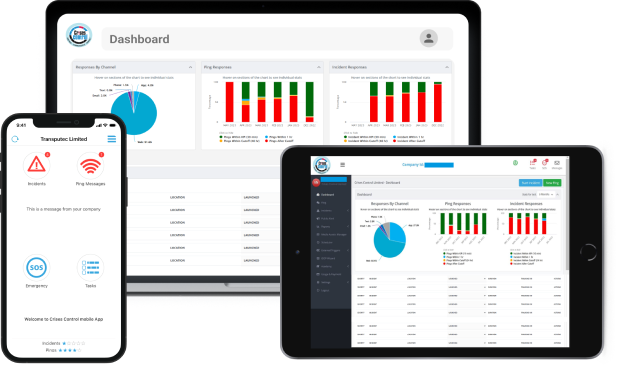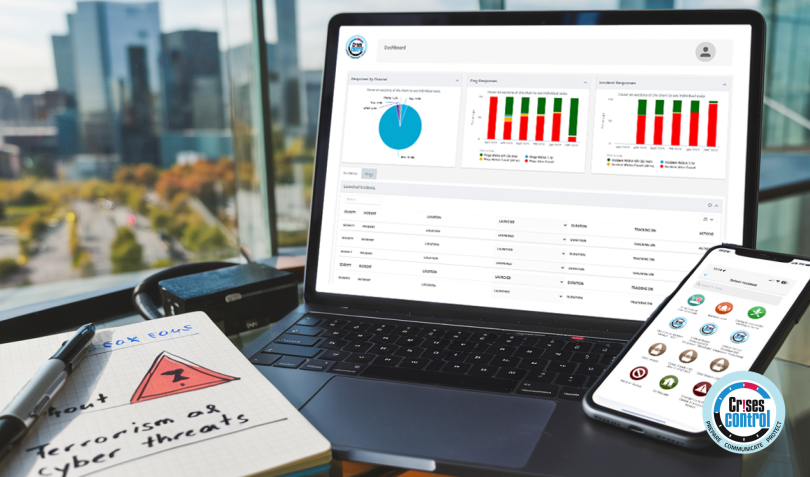Written by Anneri Fourie | Marketing Executive
European businesses are increasingly at risk from both physical and cyber threats, from terrorist attacks that disrupt public spaces to sophisticated cyber-attacks that can bring entire systems to a halt. In today’s world, being unprepared is not an option. This blog explores the real dangers facing businesses today and offers practical steps to strengthen your crisis management strategies using Crisis Management Software.
The Modern Threat Landscape: Terrorism and Cyber Attacks in Europe
Europe’s enterprises are on the front lines of a dual-threat environment where physical terrorism and cyber-attacks frequently intersect. Understanding these threats is the first step toward building a robust defence.
- Physical Terrorism Threats: Terrorist attacks targeting public spaces, critical infrastructure, and corporate offices have risen in frequency. Sectors like energy, transport, and finance are especially vulnerable. These attacks disrupt operations, endanger lives, and lead to costly repairs and downtime. For instance, the 2016 Brussels bombings severely disrupted the city’s transport network, highlighting the need for robust emergency response measures in critical sectors.
- Cyber Threats: Cyber-attacks, including ransomware, data breaches, and Distributed Denial of Service (DDoS) attacks, have become more sophisticated. In 2017, the WannaCry ransomware attack caused widespread disruption, affecting hospitals, businesses, and government agencies across Europe. The attack paralysed computer systems and cost businesses millions, demonstrating how vulnerable enterprises can be to cyber threats.
- The Need for Comprehensive Response: The convergence of these threats means that businesses can no longer rely on fragmented security measures. An integrated approach, blending physical and digital security with advanced Crisis Management Software, is essential.
The Cost of Unpreparedness: What’s at Stake?
Failing to prepare for these threats can have far-reaching consequences that go beyond immediate disruption:
- Operational Disruption: Attacks can shut down business operations, leading to lost revenue, productivity declines, and skyrocketing recovery costs. The longer the downtime, the more severe the financial impact.
- Reputational Damage: Mishandling a crisis, whether physical or digital, can lead to a severe loss of customer trust. News of a data breach or poorly managed response spreads quickly, damaging your brand’s reputation.
- Regulatory and Legal Risks: European regulations, such as GDPR, impose strict guidelines on data protection and incident reporting. Non-compliance during a crisis can result in hefty fines and legal consequences, compounding the financial and reputational costs.
- Why Crisis Management Software Matters: Investing in Crisis Management Software that integrates Business Continuity and Emergency Response Solutions helps mitigate these risks. By providing real-time data, automated alerts, and coordinated response capabilities, the right software can turn a potential disaster into a manageable incident.
Actionable Steps to Fortify Your Enterprise Against Terrorism and Cyber Threats
Strengthening your enterprise’s security posture doesn’t have to be overwhelming. Here are actionable steps that can make a real difference:
1. Conduct Comprehensive Risk Assessments
- Problem: Many businesses only assess risks once a year, missing key vulnerabilities. This reactive approach leaves enterprises exposed to new and evolving threats.
- Solution: Use tools that assess both physical and cyber risks, examining everything from on-site security gaps to digital vulnerabilities in your IT infrastructure. Ongoing assessments ensure your enterprise stays ahead of potential threats.
- Benefit: By knowing where your weaknesses lie, you can prioritise your security investments and implement targeted measures that truly protect your business.
2. Develop an Integrated Crisis Management Plan
- Problem: A plan that only addresses one type of threat, like cyber-attacks, often overlooks other vulnerabilities. Fragmented plans can slow down your response when seconds matter.
- Solution: Create a Crisis Management Plan that covers various scenarios, from terrorist threats to cyber-attacks, ensuring that everyone knows their role. Integrate Business Continuity Planning with crisis management efforts to maintain critical operations during an incident.
- Benefit: A well-crafted plan reduces response times and ensures coordinated actions, minimising the impact of a crisis on your operations.
3. Implement Advanced Crisis Management Software
- Problem: Traditional methods of managing incidents, such as phone calls and emails, are too slow and prone to error during a crisis.
- Solution: Deploy Crisis Management Software that offers incident management, automated alerts, and a mass notification system, all designed to provide a unified response.
- Benefit: Automation speeds up your response, reduces human error, and ensures that every aspect of the crisis is managed effectively from start to finish.
4. Train Your Workforce with Real-World Simulations
- Problem: Plans often fall apart without proper training. Employees may not know what to do during a real crisis, leading to delays and miscommunication.
- Solution: Use realistic scenarios to test your crisis response plans. Regular drills and simulations prepare your team for actual incidents, identifying weaknesses and refining your approach based on lessons learned.
- Benefit: Training builds confidence and competence, reducing panic during real incidents and improving the overall effectiveness of your crisis response.
5. Leverage Mass Notification and Emergency Response Solutions
- Problem: Inconsistent communication during a crisis can cause confusion, slowing down your response and potentially putting people at risk.
- Solution: Implement emergency response solutions that integrate seamlessly with your crisis management software, allowing you to send instant alerts to employees, stakeholders, and emergency services.
- Benefit: Quick, clear communication helps contain the crisis, keeps everyone informed, and supports a faster return to normal operations.
How Crises Control Can Help Your Enterprise Navigate Threats
Facing a complex crisis? Crises Control’s real-time incident management ensures that every second counts towards recovery, not chaos. With our Ping Mass Notification System, you can reach your team instantly, keeping everyone on the same page.
Real-Time Incident Management
Monitor and manage crises as they unfold with Crises Control’s real-time updates, task management, and seamless communication tools. This ensures a coordinated response to both physical and digital threats.
Mass Notification System
Quickly alert your workforce and stakeholders with multi-channel alerts that ensure critical information reaches the right people. This feature is essential during emergencies when every second counts.
Business Continuity Planning Tools
Crises Control’s platform allows you to develop, store, and regularly update your crisis response plans. The intuitive interface makes it easy to align your plans with evolving threats and regulatory requirements.
SOS Panic Button and Task Manager
The SOS Panic Button provides immediate alerts during physical threats, enabling rapid security response. The Task Manager automates task allocation, ensuring all critical actions are covered during a crisis.
Regulatory Compliance and Reporting
Crises Control ensures compliance with European data protection and incident reporting regulations. The software’s robust reporting tools help you analyse incidents post-crisis, improving your response strategies for the future.
Conclusion
The risks posed by terrorism and cyber-attacks are ever-present, and traditional crisis management strategies are no longer enough. To truly protect your enterprise, you need advanced Crisis Management Software that integrates Business Continuity Planning and Emergency Response Solutions.
Ready to transform your crisis response? Book a free demo today to see how Crises Control can keep your business safe.
Request a FREE Demo

